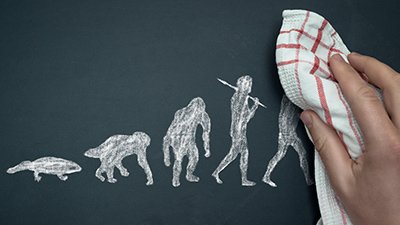
Evaluating Giberson’s Book Saving the Original Sinner with Scripture and Science
According to Dr. Karl Giberson, the molecules-to-man evolution that supposedly spawned us also made us the morally messed up creatures that we are. In Saving the Original Sinner he attacks belief in the historicity of Adam. He teaches that we are “original sinners” not as Adam’s descendants but as a result of our evolutionary heritage. Believing sin and death did not enter human history through Adam but are the natural results of evolution, he considers Adam irrelevant. Gone with Adam is the biblical foundation for understanding why the “last Adam” Jesus Christ came to die for the sins of the first Adam’s descendants. Bible-believing creationists who believe Adam and Eve were the first parents of all people refuse to accept Darwinian evolution’s explanation of human origins. Therefore, belief in Adam is a stronghold that evolutionist Karl Giberson assaults with this book, hoping to precipitate a crisis of faith in biblical creationists.
Dr. Karl Giberson1 wrote Saving the Original Sinner: How Christians Have Used the Bible’s First Man to Oppress, Inspire, and Make Sense of the World to destroy belief in the biblical Adam. Calling evolution denial “antiscience,” he complains that popular determination to cling to Adam’s historicity is “the single most important issue driving evangelical Christianity’s strong opposition to science.”2 He shares this belief with Dr. Peter Enns—another professor who was invited to leave his Christian college position after abandoning his employer’s mission to teach biblical truth. Compared to the all-out assault on Scripture in Dr. Enns’ The Bible Tells Me So,3 Saving the Original Sinner is a surgical strike on the Old Testament’s first couple.4 Acknowledging our sinfulness but not its source, Saving the Original Sinner declares, “There is no original sin and there was no original sinner,”5 but adds, “Something appropriately called sin remains a deeply rooted part of human nature and, given that we are born this way, original sin is not a bad name for it.”6

Dr. Karl Giberson wrote Saving the Original Sinner: How Christians Have Used the Bible’s First Man to Oppress, Inspire, and Make Sense of the World to destroy belief in the biblical Adam.
Troubled Evolutionary Products
Dr. Giberson portrays humans as sinful products of evolutionary drives that for millions of years rewarded greed and selfishness with survival. He writes,
For centuries those of us from the Christian tradition have understood ourselves as fallen, sinful creatures. . . . Now we understand ourselves as evolved creatures, shaped by natural selection, but unaware of what that means and how hard we will have to work to transcend those limitations.7
Humans are a “troubled species”8 needing “some kind of salvation,”9 Dr. Giberson says, yearning for a more humane world with a more enlightened moral nature. What can make us better? “Perhaps,” he concludes, “that will come from a transformed Christianity, a reenvisioned science, or from another source. It certainly won’t come by denying science. But it won’t come from pretending that when Adam vanished he took original sin with him.”10
Don’t be fooled by this book’s title into thinking it teaches about salvation from the penalty and power of sin. The gospel of Jesus Christ has no place in this book. Dr. Giberson’s portrayal of the Bible as a collection of myths and human-derived philosophies rather than as the divinely inspired Word of God leaves him with no authoritative solution for sin.
The Last Adam’s Answer
The Apostle Paul explains in Romans 5:12 that “through one man [Adam] sin entered the world, and death through sin, and thus death spread to all men, because all sinned. In 1 Corinthians 15:21–22 and 45–47 he explains that Jesus Christ, the “last Adam,” bought salvation from this sin and death. Dr. Giberson considers the connection between our ancestral Adam and Christ to be Paul’s vague device illustrating Jesus was a Savior for all people, but he admits no divine inspiration in Paul’s writings or the rest of the New Testament. Since sin and death would be the natural result of evolution, he considers Adam neither real nor theologically important, a mythical figure we do not need.
Because the passages (Matthew 4:1–11; Luke 4:1–13) describing Jesus’ temptations mention Satan but not Adam, Dr. Giberson concludes the Gospel writers thought Adam unimportant. Likewise, he ignores Jesus’ comments about the first man and woman. While his recorded words don’t mention Adam by name, Jesus said, “But from the beginning of the creation ‘God made them male and female,’” (Mark 10:6) a clear reference to Adam and Eve. Jesus Christ referred to them as real people, whether Karl Giberson agrees or not. And the burden brought upon us by their sin finally fell fully on the sinless Son of God when He, as the “last Adam,” bore that burden for us on the Cross.
For He [God the Father] made Him [Jesus Christ] who knew no sin to be sin for us, that we might become the righteousness of God in Him. (2 Corinthians 5:21)
Gone with the Adam
Having dispensed with Adam’s importance in the New Testament and his theological connection to Christ, Dr. Giberson spends a lot of ink describing how ancient Jews, classical pagan philosophers, medieval churchmen, and modern Christians have viewed man’s sin problem. To the Jews he says Adam was irrelevant except as a character in their national myth—a low view of the Old Testament expounded upon by Dr. Enns in The Bible Tells Me So. Dr. Giberson trots out the false assertion that Genesis 1 and 2 contain contradictory accounts of our origins, the first Adam-less because Adam isn’t mentioned by name. The plain reading of Genesis 1, however, presents a “big picture” account of creation, and Genesis 2 a more focused look at the origin of man. Adam and Eve are the “man” and the “male and female” of Genesis 1:26–27. While attacking the biblical writer for allegedly including contradictory information, Dr. Giberson erred dramatically when he wrote that, according to Genesis, “on the fourth day, grasses, flowers, and groves of fruit trees appear.”11
With so many different opinions about sin streaming through history, Dr. Giberson decides our sinful nature needs no Adam. “Original sin”—the human propensity to sin inherited from Adam—is a scriptural concept commonly attributed to Augustine, the 4th century Bishop of Hippo, but Dr. Giberson disputes Adam’s causal role. Many have tried to explain away Adam, minimize his importance, re-engineer him, or deny his existence altogether. Recounting discordant views and the creative ways theistic evolutionists and old-earth compromisers like Hugh Ross have re-invented our first parents, Dr. Giberson concludes that Adam and Eve must not be important anyway.
Be Fruitful, Multiply, and Fill the Earth
Why is Karl Giberson sure Adam and Eve never existed? With evolutionary science as the starting point for his thinking, he says science has conclusively shown that humans cannot have descended from two people.12 Evolutionists estimate a starter population of at least 10,000 humans would be needed to generate today’s genetic diversity. However, their population simulations depend on unverifiable assumptions about the past. Those assumptions include presumed evolutionary relationships between species, constant presumed mutation rates, constant generation times, and the evolutionary timeline for humanity’s rise.
Such mathematical gymnastics—rooted in evolutionary assumptions—cannot disprove the historical fact that Adam and Eve were the ancestors of all people, created with perfect genomes and sufficient genetic raw material to generate the last 6,000 years of human diversity. Read more about it in “Did We All Come from Adam and Eve?” and “‘The Search for the Historical Adam’ and Population Genomics.”
Body Un-designed
Dr. Giberson also claims that numerous design flaws prove a perfect God could not have designed the human body, begging the question of how innumerable “flaws” survived millions of years of culling through ruthless evolutionary selection.
The flaws he enumerates are not design flaws at all. Ignoring the immunological functions of the human appendix, for instance, he considers its existence a design flaw. Ignoring our tailbone’s crucial role as an attachment point for muscles and ligaments that keep our “insides” in despite gravity, he asserts its design is flawed. He says backs hurt and knees and hips wear out because we are not designed for bipedality, yet the curvature of the human spine and the anatomical details of the hips, knees, and feet are engineered to work together, optimizing balance and stability during the “controlled fall” we navigate with every step. Childbirth is dangerous due to flawed design, he claims. However, as described in “The Evolution of Childbirth?,” the human pelvis and the newborn skull are engineered to ordinarily guide a baby’s head through a safe and perfect path to the outside world. (See “Scars of Evolution or of a Sin-Cursed World?,” “Tie of Human Pregnancy to Bipedality Becomes Extinct,” and “Organ Recital: A Parade of Presumed Design Flaws Devoid of Truth” to learn more.)
The Fall inaugurated death as man’s destiny and, by implication, many disagreeable and dangerous experiences along the path to that day. That flaws creating dangers in childbirth, disease, and disabilities have crept into the human genome and the human population over the past 6,000 years is not evidence of bad design but of the ongoing deterioration that followed in the wake of sin’s curse. Rather than interpreting worn out parts as design flaws, we should marvel at God’s wise designs. (Check out “The Breath of Life,” “The Human Retina Shows Evidence of Good Design,” “The Seeing Eye,” “The Hearing Ear,” and Dr. Tommy Mitchell’s video presentation Evolution: The Eyes Don’t Have It.)
Broken Genes
“Adam and Eve, as described in Genesis, cannot have been historical figures. Recent work in genetics has established this unsettling truth beyond any reasonable doubt,” Dr. Giberson writes.13 A broken gene found in humans and apes—the GULO gene for making vitamin C—is Dr. Giberson’s coup de grâce in Adam’s execution.
Humans cannot produce vitamin C. We have to eat it or drink it. Genes code for a whole series of enzymes needed to produce it, and the gene encoding the enzyme for the final step is called GULO. In humans GULO does not work, at least not in the vitamin C synthetic pathway.14 The GULO gene works in dogs and cats, so they can make their own vitamin C, but in chimps and bonobos it does not.
Claims about ape and human GULO genes are a popular “proof” that apes and humans evolved from a common ancestor. “How can we possibly explain why we—and chimps and bonobos—carry the identical broken gene? Is it just a strange coincidence that those mammals that share the broken gene are the ones that evolutionary theory says are most closely related?”15 asks Dr. Giberson, claiming a resounding defeat for Adam and Eve. He adds, “It would be odd to claim that God created them with a specific broken gene that was a perfect match for one that existed millions of years earlier in the genomes of other primates.”16 How can we possibly? Is he overlooking other explanations as well as flaws in his own argument? Let’s have a look.
God our common Designer used many genes and anatomical designs in the same and similar ways in diverse species. Compared to a rat’s functional GULO, human and ape GULO genes are broken by several deletions. But are they identical? It turns out that recent research did not show ape and human GULO genes were “identical” but that they were 98% identical based on an analysis of less than 2% of the GULO sequence. A review of multiple studies comparing ape and human GULO genes reveals “The reports of high DNA similarity across the GULO gene region in human, compared to apes are primarily based on the comparison of selected exon sequences and not the entire sequence (let alone regulatory regions).”17 So much for “a perfect match”!
But don’t those breakages prove there’s ape in our lineage? Not at all! Evolutionary relationships cannot explain the observed patterns! Evolutionary scientists demonstrated in 2011 that the GULO deletion patterns “defied the standard inferred evolutionary model for primates”18—in other words, the GULO defects do not coincide with those expected from the supposed ape-human evolutionary relationship. You can read much more about this in “The Human GULO Pseudogene—Evidence for Evolutionary Discontinuity and Genetic Entropy,” but suffice it to say that Dr. Giberson’s best evidence designed to irretrievably consign belief in the biblical Adam to the rubbish bin is severely flawed, not only by evolutionary presuppositions but also by gross exaggeration.
Starting Points and Conclusions
Karl Giberson knows much about the biblical creationist message, having once accepted it. “These beliefs, once at the heart of my worldview,” he writes, “remain central to evangelical Christians’ understanding of their faith, their world, and themselves.”19 He recounts arguments20 familiar to those who have visited the Creation Museum or heard presentations by Answers in Genesis speakers. He simply does not believe them.
Sadly, Dr. Giberson says he “discovered that creationism was scientifically indefensible”21 in college. He is certain that many of the young people he saw at the Creation Museum will have similar “faith crises,”22 admitting that for two and a half decades he’s talked with youth “trying to dismantle years of antiscience indoctrination.”23 He believes science has supplied irrefutable proof of Darwinian molecules-to-man evolution.24 He says evolution-deniers live “in a zone of science denial, strangely out of touch with contemporary scholarship.”25 And in a blog posted just before the publication of his book, Dr. Giberson falsely claimed Answers in Genesis dangerously equates science with atheism.26 That is not true. Answers in Genesis strongly supports science. But there is a difference between scientific observations that can be tested and confirmed and scientific interpretations that depend on assumptions about the unobservable past.
The observations of science are not in conflict with biblical history. However, no scientist can directly observe and test our origins. Origins science is therefore entwined with a scientist’s assumptions about the conditions and events of the unobservable past. A scientist’s worldview determines what assumptions he or she considers reasonable. For Bible-believing creation scientists, reasonable assumptions are based on God’s eyewitness account of origins. Jettisoning a biblical worldview, Karl Giberson chooses to rely on man’s fallible interpretations rather than God’s Word as the starting point for his thinking.
Not a Salvation Issue
Eager to show evolutionists can be Christians, Dr. Giberson writes, “Christianity, after all, is not a religion about Adam; it is a religion about Christ.”27 No one at Answers in Genesis ministry and the Creation Museum, however, would ever suggest a person has to believe in Adam to be saved. Repentance and faith in Jesus Christ are required for salvation. A person who believes in Adam but fails to trust Jesus Christ as the all-sufficient sacrifice for his or her sins remains unsaved, spiritually dead in sin, and without hope of heaven. Yet while Adam’s historicity is not a salvation issue, the historical Adam is important for truly understanding our sinful nature, the mess the world is in, and why every one of us needs salvation through Jesus Christ.
From God’s account passed on through Moses’ writings we know who Adam was, what he did, and both immediate and long-term consequences of his rebellion against God. Through God’s Word we also know who Jesus Christ is, why He was crucified, and how His Resurrection opened the way to eternal life for all who trust in Him. By linking Adam’s sin and the resulting entry of death into human history to Jesus Christ as the last Adam and source of eternal life, God through the Apostle Paul explained that just as all people descended from Adam are sinners, so salvation through Jesus Christ is available to all.
Shame on Karl Giberson for wanting to snatch this truth from people, asserting that evolution made you who you are, and good luck on figuring your way out of the mess you are in. The history of the first and the last Adam is no fable, but a truth that helps people understand the gospel of Jesus Christ, our Creator (Colossians 1:16–17) and the Son of God whom God the Father sent “as Savior of the world” (1 John 4:14).
Further Reading
For More Information: Get Answers
Remember, if you see a news story that might merit some attention, let us know about it! (Note: if the story originates from the Associated Press, FOX News, MSNBC, the New York Times, or another major national media outlet, we will most likely have already heard about it.) And thanks to all of our readers who have submitted great news tips to us. If you didn’t catch all the latest News to Know, why not take a look to see what you’ve missed?
(Please note that links will take you directly to the source. Answers in Genesis is not responsible for content on the websites to which we refer. For more information, please see our Privacy Policy.)
Footnotes
- Dr. Karl Giberson, who holds a PhD in physics, is currently a professor of science, religion, and writing at Stonehill College. Author of Saving Darwin: How to be a Christian and Believe in Evolution and co-founder of the Biologos Foundation, Dr. Giberson considers himself one of the “martyrs for science” (Giberson, Saving the Original Sinner, 171) because he lost his position at Eastern Nazarene College after 27 years for his evolutionary teaching. Dr. Giberson writes in chapter 11 that he, Biologos co-founder Dr. Francis Collins, and Dr. Peter Enns have “agreed that the key to making peace with evolution was learning to do without a historical Adam” (Giberson, Saving the Original Sinner, 172).
- Karl Giberson, Saving the Original Sinner: How Christians Have Used the Bible’s First Man to Oppress, Inspire, and Make Sense of the World (Boston: Beacon Press, 2015), 179.
- Some assertions in Saving the Original Sinner are abbreviated versions of those elaborated upon in Dr. Enns’ book The Bible Tells Me So, and for the sake of space those will not be discussed here. Read about them in “A Critique of Dr. Peter Enns’ Book The Bible Tells Me So.”
- Dr. Enns has also written a book focused on the abolition of biblical Adam, The Evolution of Adam, which Ken Ham reviewed in “The Enns Justifies the Means?”
- Saving the Original Sinner, 176.
- Ibid.
- Ibid., 178.
- Ibid.
- Ibid.
- Ibid.
- Ibid., 16.
- This was the key point Dr. Giberson and coauthor Dr. Francis Collins argued in their book The Language of Science and Faith. It is discussed in “‘“The Search for the Historical Adam” and Population Genomics.”
- Saving the Original Sinner, 173.
- As discussed in “The Human GULO Pseudogene—Evidence for Evolutionary Discontinuity and Genetic Entropy,” evidence gleaned from the study of GULO gene deletion in mice suggests this gene is involved in more than just vitamin C production. Learn more about pseudogenes—evolutionary claims concerning them and their implications for our understanding of genetics—in “The Smell of Change in Our Understanding of Pseudogenes.”
- Saving the Original Sinner, 163 (italics original).
- Ibid., 164.
- Jeffrey P. Tomkins, “The Human GULO Pseudogene—Evidence for Evolutionary Discontinuity and Genetic Entropy,” Answers Research Journal 7 (April 2014), https://beta.answersingenesis.org/bible-characters/adam-and-eve/the-search-for-the-historical-adam-and-population-genomics/.
- Ibid.
- Saving the Original Sinner, 2.
- He includes some arguments that we consider “arguments that creationists should not use.”
- Saving the Original Sinner, 1.
- Ibid., 2.
- Ibid., 2.
- For instance, in chapter 8, Giberson says Darwin was right about natural selection being the mechanism by which increasing complexity evolved even though he was “unaware of genes and their capacity to generate novelty” (122). However, despite claims to the contrary, modern science has not demonstrated the ability of genes to generate novelty. For example, highly touted studies claiming to observe bacteria evolving new traits in reality only demonstrated that the bacteria’s “evolutionary innovation” was nothing more than the deregulation of an existing gene, not the evolution of complex, new genetic information.
- Saving the Original Sinner, 161.
- Dr. Giberson writes, “Equating science with atheism is one of the most dangerous byproducts of America's culture wars” and concludes “Ken Ham's entire Answers in Genesis project is based on it. The starting point for so many Christian [sic] has become the absolute truth of a particular interpretation of the Genesis creation story. And any alternative viewpoint is now understood to be a ‘compromise with atheists.’” “Fundamentalists Think Science Is Atheism,” Huffington Post, June 12, 2015, http://www.huffingtonpost.com/karl-giberson-phd/fundamentalists-think-science_b_7557282.html.
- Saving the Original Sinner, 171.
Recommended Resources

Answers in Genesis is an apologetics ministry, dedicated to helping Christians defend their faith and proclaim the good news of Jesus Christ.
- Customer Service 800.778.3390
- Available Monday–Friday | 9 AM–5 PM ET
- © 2025 Answers in Genesis




